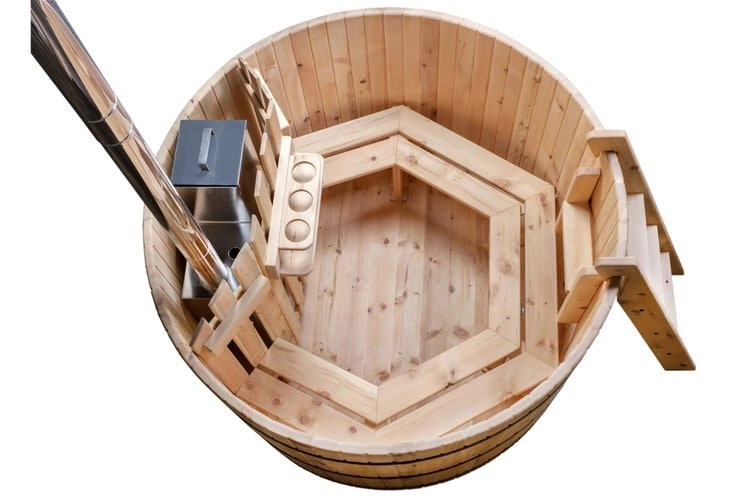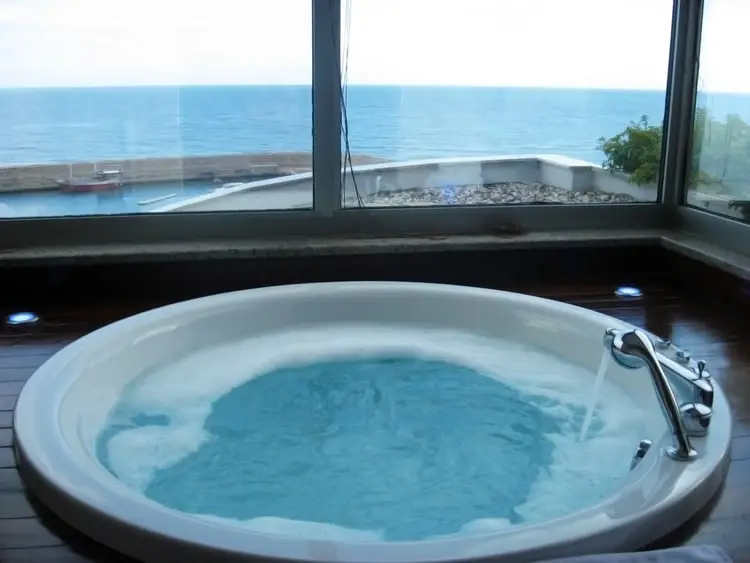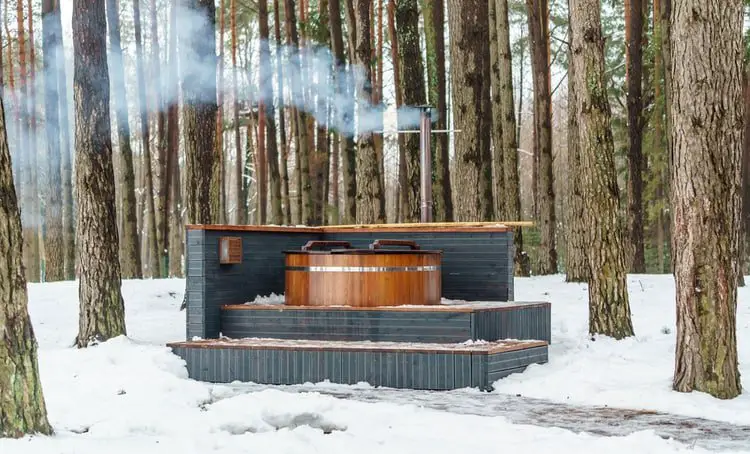Soaking in hot water is an age-old tradition with many positive health benefits. Ancient civilizations including those in Rome and Greece sought out thermal waters for their healing properties.
Japanese culture also has a strong tradition for hot baths. Modern hot tubs were introduced in the United States in the 1940s and were inspired by the Japanese soaking tubs called ofuro.
A hot tub can be a great addition to any cabin. There’s nothing nicer than a big beautiful tub to soak in indoors, or under the stars, alone, or with friends. But in the world of hot tubs, there are two power sources to choose from; electric and wood burning.

Arguably, the most significant advantages of modern technology revolve around ways and means to heat water. Before electricity and gas, gathering wood to fuel a fire for cooking and bathing was a full-time job, as was gathering and carrying water for that matter. Today, we have options, especially when it comes to pleasure appliances like a hot tub. Here, we’re going to discuss the pros and cons of each to help you decide which is right for you.
View this post on Instagram
Woodburning Hot Tub
A woodburning hot tub will probably appeal if you prefer rustic and traditional to modern and sleek.
With a wood-fired hot tub, the bath is fed by firewood through either an internal or external stove (or heater). An internal stove is submerged in the water with a partition or fence to separate it from the seating area. Wood is fed from the top of the unit.
Generally, internal stoves are more efficient since they are connected to the water – they heat up faster and can be refueled without getting out of the tub.
External stoves are located outside the tub with pipes run into the tub to warm the water by thermal siphoning. Since the stove is located away from the water source, it can take longer to heat the tub. And safety concerns should be considered if you have kids or pets that might run into the external heat source.
View this post on Instagram
Woodburning – Pros
Well let’s face it – they’re pretty romantic. They will generate a lovely campfire-like aroma. The burning stove compartment may emit a lovely flickering firelight.
If you enjoy chopping wood and have access to firewood then it’s a plus. If you live in an area with plenty of fallen trees and deadwood, a wood-burning hot tub might be a wonderful asset.
You don’t have to worry about a fat electric bill to run it.
Woodburning Hot Tub – Cons
A wood-burning hot tub can be more difficult to regulate temperature.
An external stove means you’ll need to get out of the hot tub to fuel it.
They can be trickier to clean (soot and ashes).
Need to cut and chop a supply of wood or buy local firewood.

Electric Hot Tub – Pros
It heats up within minutes
There is very little work to do when it comes to getting it up and running
You can hire a professional maintenance company
Electric Hot Tub – Cons
Well, stating the obvious – there’s a fatter electric bill to pay. They are more expensive in general to install, buy and run.
Maintenance tasks will also be more involved and time-intensive.
Wood Burning vs Electric Specs & Stats
Wood Burning
- Materials: Wood & steel or iron
- Installation Cost: $3,547 to $4,966
- Temperatures: 98.8F to 104F
- Cost to Operate: $54 to $60 per month (35 pounds of Fatwood fire starter)
- Maintenance: Wipe down tub and stove, cleaning out soot, and ash
Electric
- Materials: Acrylic, electrical components, PVC
- Installation Cost: $4,256 to $28,377
- Temperatures: 98.8F to 104F
- Cost to Operate: $42 to $56 per month
- Maintenance: Strong chemicals, complex filter replacements
Costs
There are many different brands and materials to choose from ranging from a rustic wooden barrel to luxury models with built-in speakers and other features. So there’s a wide range of prices in either type of hot tubs. Some high-tech tubs made from exquisite materials may justify their price in both beauty and quality.
With a wood-burning tub, you’re going to see simplistic designs geared toward economy and longevity. Of course, you pay for that simplicity and longevity with the additional labor required. For some, this will be a minus.
Temperatures
Wood-burning hot tubs generally don’t come with a thermostat to regulate temperatures. This means it will take more attention and work to reach the desired temperature. Also, maintaining the desired temperature will take more time, attention, and work.
If you overheat your water, it can be more difficult to stop it from reaching unpleasant temperature levels. With a wood-burning hot tub, it’s wise to keep one or more buckets of iced water on hand. In the beginning, when you’re getting used to how much wood produces how much flame, and how much flame produces how much how water, it’s going to take some guesswork.
That’s when your ice buckets are going to come in handy. But over time, with patience and practice, you’ll develop a sixth sense for how much wood and flame you need to deliver the results you want.
Electric hot tubs are easy to regulate temperatures with built-in thermostats and take little to no effort to get to your preferred temperature. However, if parts break, you’ll need to service your hot tub.
Operational Costs & Maintenance Needs
There’s a heck of a lot more technology and complexity to an electric-powered hot tub. It sucks electricity, and it will show up on your monthly bill. For many households, an extra $50 a month is a steep price to pay. For others, it’s going to be like a cool breeze blowing through your bank account. But the operational costs should also include water filters, replacement parts, and cleaning solutions. You’ll need strong cleaning solutions to kill and prevent mold, algae, and bacteria from growing in and on hard-to-reach spaces.
These will cause you to have to drain and refill the tub once in a while, which will cost you extra money. But if the ease of use and power of such a tub is worth it to you, go for it. Those hot jets are a wonderful thing.
With a wood-burning-stove-powered tub, you will need to occasionally drain it, clean it out, wipe it down both in the tub and in the wood-burning stove compartment.
If you can afford a high-quality electric tub, maybe hiring a professional service provider is within your reach as well. Taking care of a wood-burning tub is simpler, but the work may be a bit rougher, with soot and ashes to deal with. At the end of the day, the best solution may depend on your personal preferences.

